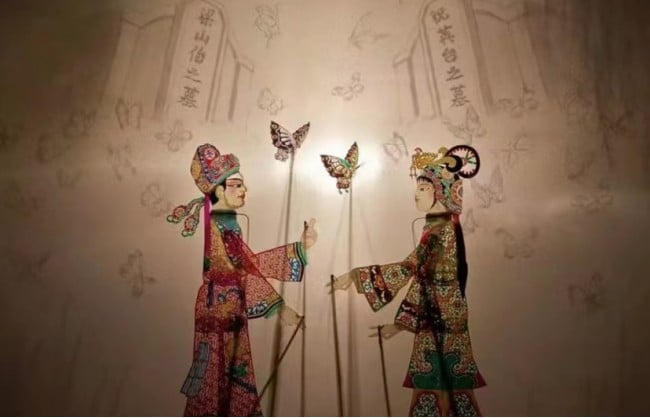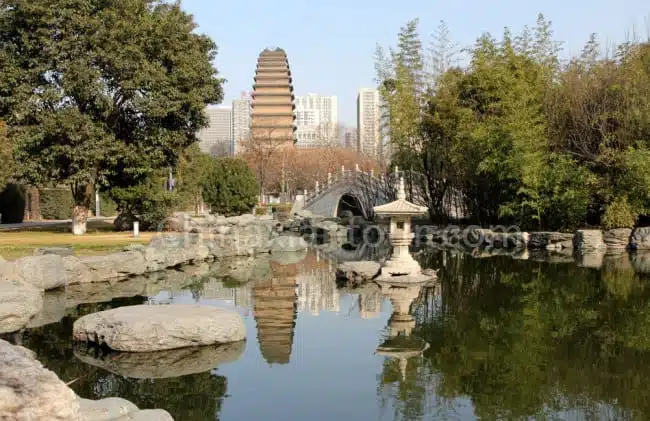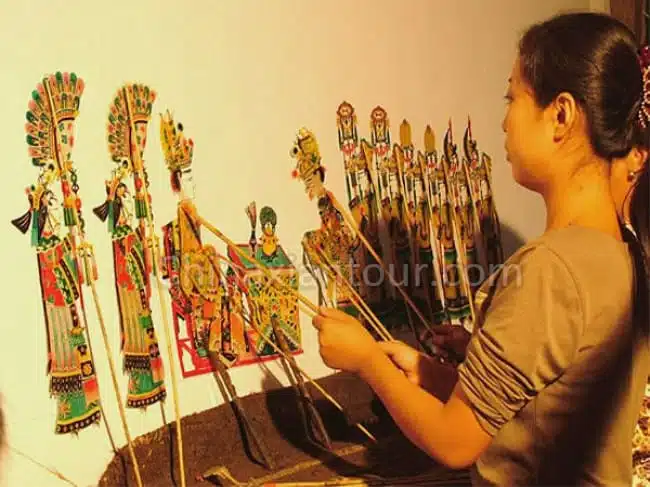Shadow Puppet and Chinese Calligraphy Experience in Xi’an
Xi’an, a millenarian ancient capital, is always the location of the soul of Chinese culture. When traveling to Xi’an, experiencing intangible cultural heritages such as the representative shadow puppet and Chinese calligraphy are top things to do in Xi’an.
Shadow Puppets: The Oldest “Movie” in the World
Shadow puppet is one of China’s earliest theatrical forms, cleverly combining folk arts and crafts with traditional Chinese opera. Shaanxi is the birthplace of China’s shadow puppet. Shaanxi shadow puppet is a valuable intangible cultural heritage, especially famous for the shadow puppets in Huaxian County.

Shadow puppet show is a type of puppetry that uses animal skins or cardboard to create character silhouettes. It is performed under the illumination of light using a blackout cloth and is widely spread among Chinese folk. During the performance, the artists manipulate the opera characters behind a white screen while singing stories in Shaanxi’s unique tunes, accompanied by percussion and string instruments, creating a strong Qin atmosphere.
Shaanxi shadow play has a simple design, rich in decorative elements, while also possessing exquisite and skillful artistic features. The performance forms of shadow puppet are diverse, and can interpret historical stories, myths and legends, folk stories, etc.
Experiencing Shadow Puppet Show in Xi’an
Shadow puppet originated in Guanzhong Area (around Xi’an) in the Western Han Dynasty, with a history of over 2000 years. However, since the late 1980s, this folk art has been on the wane, with fewer and fewer old artists and fewer young people willing to learn and inherit the treasure.
In order to revive its former glory and disseminate it among more people, Xi’an Museum has set up a base of traditional culture inheritance in the north gate of Small Wild Goose Pagoda (Xiaoyanta), and put up a stage in the Yanyuan Garden. It has also officially hired some masters to perform shadow puppet of various genres of drama. The shadow puppet performing hall is located in a prominent position in the Garden, which consists of two floors with the accommodation of 100 people at the same time. The environment there is also elegant and comfortable.

Apart from the shadow puppet show, Xiaoyanta also showcases other non-material cultural arts such as paper-cutting, wood-block print, clay figurine, seal carving, and oil-paper umbrellas. Visitors can extra experience the hand-rubbing inscriptions and Chinese calligraphy learning to feel the charm of traditional culture. Roaming in the courtyard of Xi’an Museum, visitors are always immersed in this elegant space, with accompanied by water, bamboo, flowers, birds and especially a sense of tranquility.
During your Xi’an tours, you can also go to Gao Family Courtyard and Qin Zhiyun Shadow Puppet Theater located in the Muslim Quarter, Shaanxi Opera Museum (Yongxingfang) and other places to watch shadow puppet shows.
In addition, Xi’an Ming and Qing Shadow Puppetry Art Museum, which is hidden in the Datang Everbright City, is also a great place to learn about the ancient shadow puppetry art.

Chinese Calligraphy: One of the Four Chinese Traditional Arts
Chinese calligraphy is a traditional art unique to Chinese characters, known as “wordless poetry, intangible dance, painting without pictures, silent music”. Calligraphy uses a brush to write Chinese characters, combining the character’s structure, composition, ink technique, and font style to create aesthetically pleasing works of art that express the spiritual world of calligraphers.
Chinese calligraphy has a long history and has undergone the evolution of various fonts. From oracle bone inscription (甲骨文), bronze inscription (金文), seal script (篆书), clerical script (隶书), regular script (楷书) to running script (行书) and cursive script (草书), each font has its unique style and historical background.
Types of Chinese calligraphy styles: seal script has round strokes and rigorous structure; clerical script has a flat form and emphasizes symmetry; regular script has a square structure and a well-organized composition; running script should be of appropriate size and density; cursive script has concise strokes and flexible structure.
In terms of tools and materials, Chinese calligraphy mainly uses a set of brush, ink, paper, and inkstone. In 2009, “Chinese Calligraphy” was included in the Representative List of the Intangible Cultural Heritage of Humanity by UNESCO.
Chinese Calligraphy Appreciation Tour in Xi’an
Friends interested in Chinese calligraphy can visit Xi’an Stele Forest and Xi’an Chinese Calligraphy Art Museum to experience the charm of calligraphy art.
Xi’an Stele Forest Museum, a paradise for calligraphy enthusiasts, has the largest collection of ancient stone tablets. As one of the hottest museums in Xi’an, Stele Forest is a gathering place for stone inscriptions of Chinese ancient cultural classics, as well as famous calligraphy art treasures throughout history. Remember to hire a guide!
The Shuyuan Gate (书院门) near Stele Forest is a famous ancient cultural street in Xi’an. It has become a must-visit place for calligraphy and painting enthusiasts, and among the dazzling array of calligraphy and painting stalls, there are no shortage of skilled masters and experts with excellent works.
Xi’an Chinese Calligraphy Art Museum is the first calligraphy art themed museum in China. The museum is composed of 9 exhibition areas, among which the Chinese Calligraphy History Exhibition Area focuses on precious relics of ancient calligraphy, calligraphy inscriptions and ink marks that leaved a name in history. The Qin Sealing Clay displayed here is a remarkable historical treasure.
Apart from the above, the 1600-year-old Caotang Temple (草堂寺) located in Huyi District, Xi’an, is also a good destination for tourists interested in Chinese calligraphy inscriptions and Buddhist culture.









